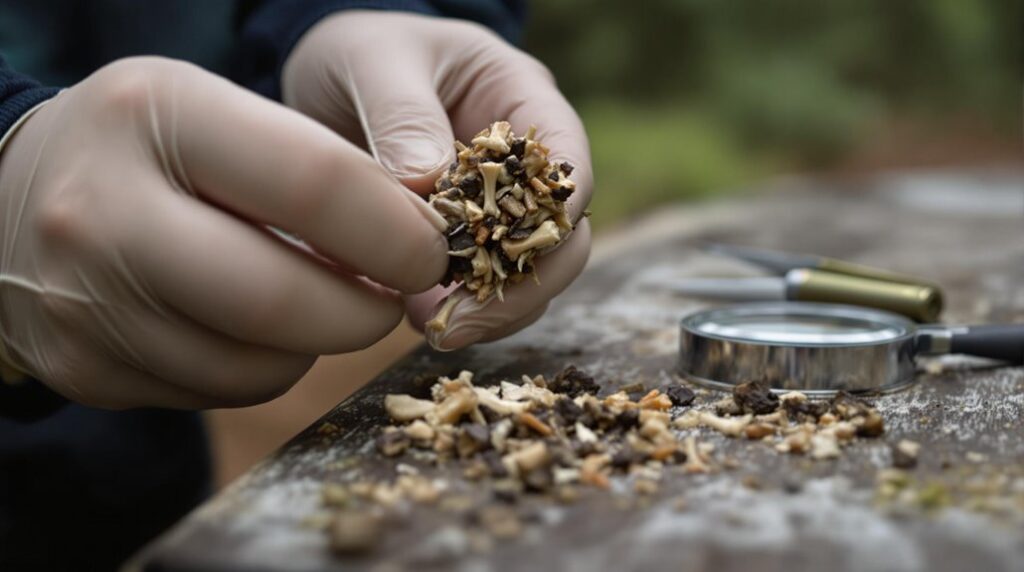The pellet count method is a cost-effective way to estimate wildlife populations, especially for ungulates like deer and moose. You can gather valuable data on species abundance and habitat use by counting animal droppings in defined plots or along transects. It’s a reliable approach that provides precision comparable to other methods, with 95% confidence intervals typically under 7.5% in small areas. You’ll gain insights into habitat preferences and the impact of human activities on wildlife. Proper sampling design and data analysis are key to accurate results. Keep exploring to discover how this method can inform conservation strategies.
Principle and Application

The pellet count method relies on a straightforward principle: the more deer in an area, the more pellet-groups you’ll find. It’s a commonly used technique for estimating ungulate population density, particularly deer. By counting these droppings within defined plots, usually along transects, you can infer the relative abundance of animals in different areas or monitor population changes over time. PELLET is an Excel-based tool designed to facilitate the analysis of pellet-group count data for deer density estimation.
To get reliable results, you need to take into account critical factors like defecation rates, pellet-group persistence, and spatial distribution patterns. Sampling schemes typically involve either transects with circular plots (TCP) for medium to high deer densities or strip transects (ST) for lower abundances. You’ll count recent pellet-groups within each plot, noting their age to guarantee accurate density calculations later on.
Once you’ve collected your pellet-group data, plug it into a formula that accounts for variables like defecation rate, days since leaf-off, and plot area. Tools like PELLET in Excel can streamline these calculations while incorporating variability.
After adjusting for factors like deer harvest and winter mortality, you’ll have a deer density estimate, complete with confidence intervals to gauge precision. While it requires careful design and execution, especially in smaller landscapes, the pellet count method offers a practical way to assess deer populations without directly observing the animals themselves.
Species Covered
You can apply the pellet count method to a variety of ungulates and other mammals. It’s commonly used for big game species like moose (Alces alces), white-tailed deer (Odocoileus virginianus), mule deer (Odocoileus hemionus), roe deer (Capreolus capreolus), and wapiti (Cervus canadensis).
The method also extends to other game species such as fallow deer (Dama dama) and bison (Bison bison).
In general, you’ll find the pellet count method employed for ungulates, lagomorphs, and even elephants. It’s a versatile technique that’s not limited to a specific taxonomic group, as long as the animals produce distinct pellets or droppings.
You’ll come across regional applications of the pellet count method tailored to specific species and habitats. For example, it’s been used to estimate moose populations in central Finland and white-tailed deer in tropical dry forests and the U.S. Midwest. The pellet count method has also been applied to assess moose habitat use patterns in Finland.
Keep in mind that while the pellet count method is widely applicable, you should consider the specific characteristics and behavior of the target species when designing your study.
Factors like pellet decomposition rates, defecation patterns, and habitat preferences can vary among species and influence the accuracy of your population estimates.
Reliability and Precision

When evaluating wildlife survey methods, reliability and precision are essential factors to contemplate. The pellet count method has been found to provide consistent estimates that align with other techniques like drive counts and FLIR aerial counts. Curiously, the reliability of the method isn’t greatly affected by the experience level of the counters in small landscapes, although individual defecation rates and observer bias can introduce some error. However, this error can be controlled to maintain the method’s reliability for estimating deer density under most field conditions. Pellet-based surveys are noted for their cost-effectiveness and efficiency compared to expensive aerial and spotlight surveys.
In terms of precision, the pellet count method excels in small landscapes, with 95% confidence intervals less than 7.5% of mean estimates and coefficients of variability below 10%. Even in larger landscapes, the precision remains acceptable, with confidence intervals ranging from 18.4 to 30.4% of mean estimates and coefficients of variability under 25%.
Quadrat sampling tends to produce the most precise estimates compared to line and strip transects. Precision may also be influenced by deer density, with higher densities leading to more homogeneous pellet group distribution.
To guarantee reliability and precision, a random sampling framework across the entire landscape is vital. Observer experience, decomposition rates, pellet group age, and landscape conditions can all influence the method’s performance, but these factors can be controlled through proper training, methodology, and timing of surveys.
The pellet count method’s cost-effectiveness, ease of application, and wide applicability make it a valuable tool for deer management, habitat impact assessment, and population trend monitoring across various landscapes and conditions.
Methodological Approaches
Pellet count methodologies offer a versatile toolkit for evaluating wildlife populations and habitat use across diverse landscapes. You can apply pellet counts simultaneously to multiple species with differing activity patterns and behavior, making them suitable for use over large areas in most habitats. They provide an indicator of spatial or temporal habitat use, and have been employed to determine the habitat use of various species, including moose, deer, wapiti, bison, and roe deer. Pellet counts are essential for understanding ecosystem dynamics and herbivore impacts.
When conducting pellet counts, you have the option of using plot sampling or strip sampling procedures. Keep in mind that plot sampling may overestimate densities compared to strip sampling. However, different plot intervals in plot sampling can yield similar results regarding habitat use patterns.
To carry out the counts, you’ll lay out plots along a transect line at regular intervals, following specific rules for counting pellet groups. Each group must consist of a minimum number of pellets within the plot to be counted.
Pellet group densities reflect habitat affinity, particularly concerning food availability, with higher densities observed in areas with abundant winter food sources. By classifying habitat use patterns using pellet group counts, you can gain insights into how species utilize different habitat types. This information proves especially valuable in winter when food becomes a limiting factor.
Additionally, annual pellet counts help assess the health balance between large herbivores and their habitat, aiding in determining the impact of deer on habitat quality as carrying capacity varies with habitat quality and declines with increasing deer numbers.
Data Collection and Analysis

Effective data collection and analysis form the foundation of pellet count studies. You’ll need to carefully set up transects across your study area in a semi-random or grid pattern. Plots, either circular or rectangular, should be placed at regular intervals along these transects. Pilot studies are essential before field applications to refine sampling design.
When counting pellet groups within the plots, focus on recent ones, typically from the last 6 months, to guarantee data relevance. Trained observers should count the pellet groups and record the number per plot, along with other observations like old pellet groups and signs of other animals.
There are several techniques for counting pellet groups, including total counts, presence/absence, point distance-nearest neighbor, and recruitment rate. Edge effects should be accounted for by counting pellet groups if half or more lie within the plot or strip.
Data analysis involves density estimation using the total number of pellet groups and known defecation rates. Adjusting for defecation rate and pellet decay improves estimate accuracy. Calibration with known densities or other methods enhances reliability.
Statistical methods like confidence intervals and coefficients of variability assess precision. Comparing pellet group counts with other methods such as drive counts and aerial counts helps validate your findings.
When interpreting the data, consider seasonal variation, habitat influence, observer bias, decay rates, and historical data. By carefully collecting and analyzing data, you’ll gain valuable insights into deer population dynamics and make informed management decisions.
Limitations and Considerations
Although pellet count studies provide valuable insights into deer population dynamics, they come with certain limitations and considerations you should keep in mind. Visibility and detection issues can affect the precision of your data over time. You may find that detection rates vary with habitat and seasonal changes, especially after leaf fall. Determining the age of pellets can also be challenging. Error sources like variable individual defecation rates and observer bias can further complicate your analysis. Keep in mind that pellet decomposition rates differ according to habitat and diet. Precision measures were reported for only 32% of estimates analyzed, indicating a significant gap in methodological reporting.
When designing your study, carefully consider plot size and shape. Ideal dimensions depend on the species you’re studying and the density of pellets in the area. While larger plots may increase detection, they could also increase sample variance. Avoid plots with high perimeter:area ratios, as they can lead to sampling and observer bias. Long, thin plots can effectively intercept scattered pellet groups but may introduce bias. Remember that different species require different plot sizes.
Pellet counts have methodological limitations. They don’t provide information on sex ratio or age structure and rely on accurate defecation rates, which can vary. The method is sensitive to pellet degradation over time and can’t account for short-term changes in habitat use. For extensive population assessments, you may need to employ alternative methods like aerial counts.
Comparing pellet counts with other methods can reveal underestimation of densities. While cost-effective, pellet counts may lack the precision of more expensive methods. Combining pellet counts with other techniques can enhance overall accuracy and understanding.
Habitat Use Insights

Habitat use insights derived from pellet count studies offer valuable information about how animals interact with their environment. You’ll find that pellet counts reveal diverse habitat utilization patterns across various species, including moose, deer, and wapiti. These patterns can vary markedly across seasons, reflecting changes in food availability and weather conditions. For instance, moose prefer young Scots pine dominated thinning stands in winter due to high food availability.
By analyzing pellet counts over time, you can create maps of habitat use and selection patterns, which aid in conservation planning. You’ll discover that factors such as elevation, vegetation, and human activities influence habitat use dynamics. Pellet counts provide insights into resource utilization and habitat specialization, as seen in pronghorn habitat selection.
Anthropogenic impacts on habitat use patterns can be identified, as demonstrated in studies on brown bears in Greece. You’ll learn that certain habitats serve as seasonal refuge areas for species like brown bears. Incorporating habitat selection data into models allows you to predict future habitat use patterns, informing conservation efforts.
Pellet count data enables spatiotemporal analysis of habitat use, aiding in habitat management strategies. You’ll understand that different species have specific habitat needs, which can be identified through pellet count analysis.
This knowledge supports targeted conservation efforts and helps address the dynamic nature of habitats in the face of environmental changes. By leveraging habitat use insights from pellet counts, you can make informed decisions to protect and conserve wildlife populations and their critical habitats.
Sustainable Management Implications
Pellet count studies have significant implications for sustainable wildlife management. They’re compatible with existing methods and can be used alongside direct observation to provide valuable insights into habitat use and population density. This cost-effective approach offers a reliable alternative to aerial counts and can be integrated with other strategies like hunting to help reduce overabundant populations to levels acceptable for forestry, agriculture, and conservation. Pellet-group counting generally requires less funding and equipment compared to alternative methods like aerial surveys and camera traps.
Pellet counts are essential for environmental sustainability. They help manage species that negatively impact ecosystems when overabundant. The method is useful for evaluating habitat suitability across different forest types and management practices, providing the data needed to determine when and where to reduce deer density. By facilitating reliable population estimates, pellet counts support sustainable management efforts to maintain desirable herd health and ecosystem balance.
The pellet count technique is methodologically reliable, yielding precise estimates with confidence intervals often less than 10% of the mean. It’s suitable for northern hardwood forests where pellet degradation is minimal and requires little equipment and training, making it accessible. When adjusted for hunter harvest and overwinter mortality, pellet counts provide accurate population estimates.
Pellet count studies align with policy and regulatory demands, such as the EU’s requirement for national wildlife management programs. They support the need for accurate and precise population density estimates for management planning and help address human-wildlife conflicts through informed decision-making.
Future Method Refinements

Refining the pellet count method is important for enhancing its accuracy, precision, and applicability in sustainable wildlife management. By leveraging technological advancements, you can improve data collection through the use of drones, remote sensing, GIS, and high-resolution aerial photography. These tools allow for more efficient and accurate mapping of pellet distribution and deer populations. Elevated tail behavior can also be observed using these technologies, aiding in the identification of fresh pellet groups.
Additionally, incorporating machine learning algorithms can automate the identification and counting of pellet groups in images, saving time and reducing human error.
To further enhance the reliability of the pellet count method, it’s essential to focus on standardization and calibration. Standardizing plot sizes, shapes, and observer training protocols can minimize variability across different landscapes. Calibrating pellet decomposition rates for various habitats and climatic conditions is important for accurate estimates. Regular calibration against independent methods, such as FLIR or drive counts, guarantees the validity of the results.
Methodological refinements are key to improving the precision and reliability of pellet counts. Evaluating the best plot size and shape for low-density populations, investigating the relationship between pellet density and deer abundance in diverse landscapes, and analyzing the impact of habitat characteristics on decomposition rates are significant steps.
Refining the density estimation formula to account for environmental factors and continuously monitoring and adjusting methodologies are necessary for long-term accuracy.
Finally, integrating pellet counts with other non-lethal detection methods, such as camera traps and track plates, provides a thorough understanding of wildlife dynamics. Combining pellet counts with habitat surveys and other ecological data can help predict potential changes and impacts on wildlife populations, enabling more informed and sustainable management decisions.
Cross-Species Applicability
While methodological refinements are essential for improving the pellet count method, its cross-species applicability is another vital aspect to contemplate. The method’s been commonly used for estimating population densities of various deer species, snowshoe hares, and other ungulates. However, you must consider species-specific factors, such as habitat influence on decomposition and defecation rates, as well as regional adaptations due to variations in climate, vegetation, and animal behavior.
To effectively apply the pellet count method across species, you may need to adapt sampling schemes, plot sizes, and seasonal adjustments based on the target species’ abundance, habitat use, and behavior. Proper observer training in identifying and counting pellet groups is also essential for accurate cross-species application. Additionally, statistical models should be adapted to account for variations in pellet decomposition and defecation rates among different species.
Comparative studies have highlighted the importance of recognizing inter-species variability in the method’s performance. These studies have compared the pellet count method between deer and hare populations, as well as across different regions, emphasizing the need for species-specific considerations. Evaluating the accuracy of the method across species is vital for reliable population estimates and developing robust conservation strategies.
The pellet count method’s cross-species applicability has significant conservation implications. It can be used to monitor population trends, guide habitat management strategies, and identify areas of high conservation value across multiple species.

Erzsebet Frey (Eli Frey) is an ecologist and online entrepreneur with a Master of Science in Ecology from the University of Belgrade. Originally from Serbia, she has lived in Sri Lanka since 2017. Eli has worked internationally in countries like Oman, Brazil, Germany, and Sri Lanka. In 2018, she expanded into SEO and blogging, completing courses from UC Davis and Edinburgh. Eli has founded multiple websites focused on biology, ecology, environmental science, sustainable and simple living, and outdoor activities. She enjoys creating nature and simple living videos on YouTube and participates in speleology, diving, and hiking.
🌿 Explore the Wild Side!
Discover eBooks, guides, templates and stylish wildlife-themed T-shirts, notebooks, scrunchies, bandanas, and tote bags. Perfect for nature lovers and wildlife enthusiasts!
Visit My Shop →
